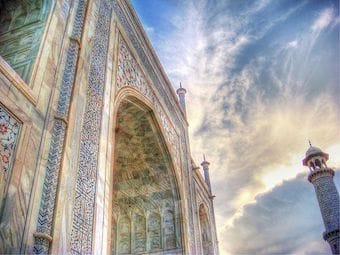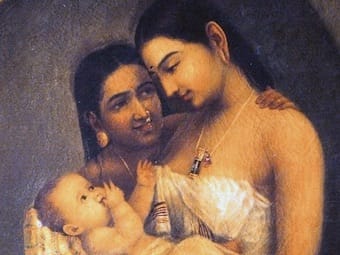Intricate decorations on the Taj Mahal, seen on a day of unsettled weather in Agra, Uttar Pradesh, about 100 miles south of New Delhi. Craik was spellbound by the beauty of the Taj. “That beauty sinks the deeper the longer we linger by it; it is increased by each visit; it is enhanced by every sight of it — in the hazy mists of the morning, in the blaze of the mid-day sun, when the evening shades are lengthening, and, more perhaps than all, in the cold silvery light of the moon under a sky of deepest blue.”
The story of Shah Jahan, with all his easy bonhomie, his laxity of creed, his life of mingled fighting and debauchery, blended with his passionate and enduring love for the wife of his youth, and the sadness of his closing years, must always have an interest of its own. But in this creation of surpassing beauty I can find nothing that reflects the sadness of human fate, or that tells of the all-pervading solemnity of death. There is nothing of sad or mournful reminiscence, nothing of the infinite regret for love that is only a memory. It tells of no grief for the immutable decrees of fate; it is a defiance of death by associating it with all the bright and gossamer gleam of sunlight and of fairy beauty. It stands supremely alone, not by the power of any pathos, or of any appeal to the sympathy which the woes of humanity evoke, but as the brightest, the most joyous, the most luxuriant monument of death and decay that the world has ever seen.
Abridged
Questions for Critics
1. What is the author aiming to achieve in writing this?
2. Note any words, devices or turns of phrase that strike you. How do they help the author communicate his ideas more effectively?
3. What impression does this passage make on you? How might you put that impression into words?
Based on The English Critic (1939) by NL Clay, drawing on The New Criticism: A Lecture Delivered at Columbia University, March 9, 1910, by J. E. Spingarn, Professor of Comparative Literature in Columbia University, USA.
Précis
Craik reflected that although the Taj was a mausoleum for Shah Jahan’s wife, and that Shah Jahan was himself a troubled and conflicted man, the whole edifice seemed wholly without sadness, regret or poignancy; in all the world, there was no other monument to the dead so full of celebration and joy. (52 / 60 words)
Craik reflected that although the Taj was a mausoleum for Shah Jahan’s wife, and that Shah Jahan was himself a troubled and conflicted man, the whole edifice seemed wholly without sadness, regret or poignancy; in all the world, there was no other monument to the dead so full of celebration and joy.
Variations: 1.increase the length of this precis to exactly 55 words. 2.reduce the length of this precis to exactly 45 words. 3.introduce one of the following words into the precis: because, besides, if, just, may, must, unless, whether.
Archive
Word Games
Jigsaws Based on this passage
Express the ideas below in a single sentence, using different words as much as possible. Do not be satisfied with the first answer you think of; think of several, and choose the best.
Spinners Find in Think and Speak
For each group of words, compose a sentence that uses all three. You can use any form of the word: for example, cat → cats, go → went, or quick → quickly, though neigh → neighbour is stretching it a bit.
This exercise uses words found in the accompanying passage.
1 Dwarf. Pure. Warm.
2 Always. Bright. Deep.
3 Find. Over. Passionate.
Variations: 1. include direct and indirect speech 2. include one or more of these words: although, because, despite, either/or, if, unless, until, when, whether, which, who 3. use negatives (not, isn’t, neither/nor, never, nobody etc.)
Confusables Find in Think and Speak
In each group below, you will find words that are similar to one another, but not exactly the same. Compose your own sentences to bring out the similarities and differences between them, whether in meaning, grammar or use.
This exercise uses words found in the accompanying passage.
Add Vowels Find in Think and Speak
Make words by adding vowels to each group of consonants below. You may add as many vowels as you like before, between or after the consonants, but you may not add any consonants or change the order of those you have been given. See if you can beat our target of common words.
crtns (5+2)
cartons. cartoons. creations. cretins. curtains.
cretinous. croutons.
Post Box : Help Available
You are welcome to share your creativity with me, or ask for help with any of the exercises on Clay Lane. Write to me at this address:
See more at Post Box.
If you like what I’m doing here on Clay Lane, from time to time you could buy me a coffee.
Buy Me a Coffee is a crowdfunding website, used by over a million people. It is designed to help content creators like me make a living from their work. ‘Buy Me a Coffee’ prides itself on its security, and there is no need to register.






